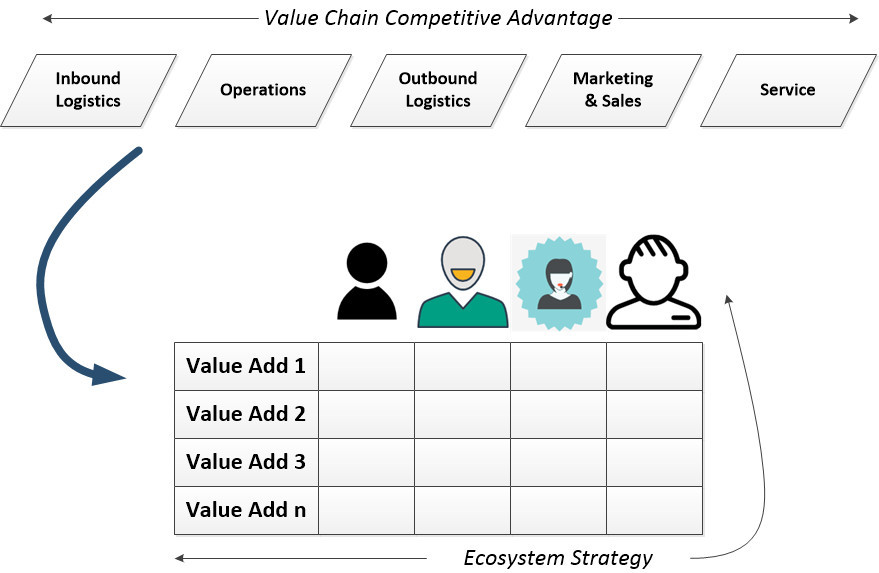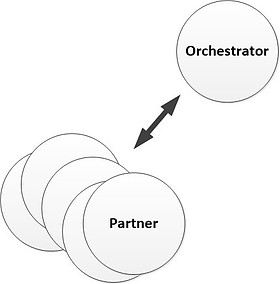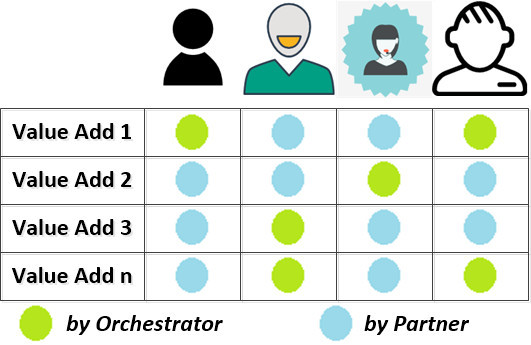Digital technology has disrupted industries and created widespread opportunity for value creation. How can organizations find their place in this new order? What are the new strategic opportunities? In part, the answer lies in developing custom strategies and implementing projects to position the company in the appropriate business ecosystems. It goes beyond what the firm can do itself to what the firm can do in partnerships with other organizations.
The Basics: What Is the Ecosystem Strategy?
Ecosystem strategy is a major leap from the strategic basics first put forth by Michael Porter. Here’s how.

The upper diagram illustrates the more industrial, value chain oriented approach to competitive advantage strategy. There are a few things that pop out in that upper diagram:
- Singular to the firm – The value chain shows value added steps purely executed by the single firm.
- Sequentially process oriented – Value added is somewhat inward looking. The focus appears to be one ‘getting product out the door’ with just a few major value added steps.
- Not particularly customer driven – While customer needs are surely considered, at least in a broad sense, value seems to be driven largely by operational considerations.
Now, moving to the lower diagram in the figure, this is the new ‘ecosystem strategy’ approach. The chart shows a vertical dimension with an unlimited number of value add components. Along the horizontal dimension are customers, or groupings of customers that share common needs and desires.
Here’s what immediately jumps out from the ecosystem strategy figure:
- A system for delivery – Something different and less visible is knitting together the delivery system. Delivery seems almost transparent and assumed – embedded in one or more of the value adds that contribute to the customer experience.
- Job-to-be-done oriented – The customer icons indicate a way of grouping customers according to needs. It is deeply customer centric. It indicates a focus on the driving force of the job that customers are trying to get done.
- Intersection of value add and customer needs – The grid opens the possibility for ‘nodes’ at the intersection of customer needs and value to be added, which can drive strategic moves.
Thus, we have for ecosystem strategy a structure or system for capturing an almost unlimited number of small advantages that add up to one big one. The ecosystem strategy uses that multitude of advantages as a network effect that builds the protective competitive moat.
Indeed, the McKinsey article “How do companies create value from digital ecosystems?” asserts that “value chains are consolidating into ecosystems.”
What Makes Up a Business Ecosystem?

A business ecosystem consists of a wide variety of stakeholders, including suppliers, producers, distributors, customers, service providers, regulators, and more. But structurally and strategically, beyond all of these stakeholders, there are two primary players in a business ecosystem:
- Orchestrator
- Partner
Orchestrators need to have the financial, market, relationship, and core capabilities muscle to organize an effective widespread ecosystem, as well as to withstand the competitive threat from another would-be orchestrator in the space. If a company does not have a strong position, it is better off stepping back into a partner role.
Let’s look at a few ecosystems as examples.
Amazon
As the orchestrator, Amazon has partnership programs in numerous areas, and thus orchestrates numerous ecosystems. To mention a few, Amazon allows entrepreneurs to
- Piggyback on its infrastructure and magnetic pull to build e-commerce stores
- Add services on top of Amazon Web Services (AWS)
- Sell products online through Amazon Affiliates
Amazon profits by extending its reach well beyond where it could on its own. Partners within the various programs, or ecosystems, can make money, but need to abide by rules and work within the infrastructure that Amazon has set up. The system only works when both Amazon and the partners do sufficiently well to justify the effort.
Microsoft
Microsoft has been well-known for its extensive partner programs for delivery of software and training. The basis for this is that, while Microsoft has had the reputation and widespread adoption of its software, it has needed partners to:
- Sell a combination of Microsoft software with design, development, and support services
- Provide training to expand the knowledge base in Microsoft products
- Build a community of experts that commit to Microsoft vs other software products
Microsoft continuously feeds and updates this ecosystem as it continues to evolve.
Salesforce
The Salesforce platform originally was focused on a narrow range of sales applications. It has since grown outward to include products and services in more distant but adjacent areas to the sales function through the use of partners that could extend the reach. The process in general is:
- Identify what customers want
- Identify the capabilities needed
- Decide whether to provide internally or through partners
There are value added functions where both Salesforce and its partners insert their capabilities into the ecosystem as it evolves.
The key to success of the ecosystem in all cases is that both orchestrator and partner need to be able to prosper. It is a two-way relationship. The orchestrator controls the system, and also participates in some specific value added activities for customers. The orchestrator seeks partners to provide value added products and services for unfilled customer needs.
Benefits, Pitfalls, and Risks of Business Ecosystems
It is very difficult to be a successful orchestrator at larger scale. It usually should only be attempted by large enterprises, such as those in the examples above. However, there are opportunities for smaller companies…and note that not too long ago none of those companies above even existed!
It does seem possible to orchestrate a business ecosystem on a smaller scale, if the competitive niche is small enough. A case in point is niche software, where small providers have focused partner programs to help sell and implement the software products. In the project management software niches, for example, many providers have a cadre of sales, implementation, and referral partners to expand their reach. They have created a small business ecosystem that can work.
Back to thinking on a large scale, where we can gain insights that can be used in large and small, McKinsey, in its article “Ecosystem 2.0: Climbing to the next level“, cites four (4) reasons for failed business ecosystem efforts:
- “Go deep or go home” – The key here is to rethink value chains – value chains are not dead but evolving. The customer is king today, and strategic thinking – including design thinking – to connect more deeply to the customer experience is where orchestrator and partner both must excel.
- “Move strategically, not conveniently” – Areas adjacent to the existing business are a good place to begin, but they are only a starting point. From there, it is most important to identify new products, services, or tweaks to existing that provide tangible value to customers – such as decreased cost, less time, or better results.
- “Partner with vision” – Detailed clarity is needed as to what the orchestrator and partners will each bring to the customer. What skills and capabilities will bring value to customers, which does the orchestrator vs partner bring, and how will they be knitted together seamlessly?
- “Clear the path to impact” – Cultural resistance is a common hurdle, especially for large successful companies. There are some key theories for overcoming the inertia of big success in order to transition to greater success in an evolving environment. For more on this, see “The Innovator’s Dilemma: When New Technologies Cause Great Firms to Fail” by Clay Christensen.
In addition to these challenges for orchestrators, partners also have significant challenges. The biggest is the need to deliver results within the framework laid out by the orchestrator. If a partner cannot deliver these results, they will be better off seeking other opportunities.
Strategies and Projects to Build a Strong Position in the Ecosystem

The strategy for building a business ecosystem needs to proceed along several key lines of effort.
- Control Points are the starting point – Shown as the green and blue dots on the chart at right, control points can indicate whether your company is best to pursue the orchestrator role, or better leaving that to a firm better situated and pursue a partner role. It also illuminates all the roles that have potential to create customer value in the ecosystem, from mapping value chain capabilities to the customer needs and customer journey for each type of customer.
- Create value from the right capabilities – Based upon strategic analysis, it may be necessary to reconfigure internal capabilities to meet shifting demands. Or, it may be more appropriate to set up partnership arrangements to fill gaps in capabilities. The important thing is to prioritize the capabilities that are most needed and to make sure they are filled with best of breed providers.
- Design the ecosystem to scale – Ecosystem strategies require a drastically different value chain, so scaling is very different. It needs to have internal/orchestrator capabilities that can scale to meet the projected ecosystem size, partners who can scale, and an infrastructure that can scale to meet a strong and growing numbers of both partners and customers.
—————————————-
I recommend these PM templates (paid link):
—————————————-
Projects, programs, and portfolios are the natural outcome of the analysis. They come from a combination of strategic decisions like prioritizing where capabilities and customer needs intersect (control points), prioritizing how and when capabilities will be developed, and proceeding with a scalable approach. The result is a portfolio of projects and programs that reflect these priorities and allow the organization to learn and evolve.
Summary: What Is the Best Ecosystem Strategy?
There is no single best ecosystem strategy!
For any organization, the first decision is whether to be an orchestrator or partner. Risks and opportunities of each were touched upon above. From there it is a matter of maintaining a keen customer focus and adding value for customers on your chosen path.
Here are some additional resources:
- “In the Ecosystem Economy, What’s Your Strategy” by Michael G. Jaobides, Harvard Business Review
- “Ecosystem Businesses Are Changing the Rules of Strategy” by Julian Birkinshaw, Harvard Business Review
- “Predators and Prey: A New Ecology of Competition“, by James F. Moore, Harvard Business Review
- “Startup Ecosystem Implementation Toolkit“, FlevyPro library
- “Digital Transformation: Integrated Business Ecosystems“, FlevyPro library
- “Digital Transformation: Integrated Business Ecosystems Primer“, FlevyPro library
- “Digital Transformation: Customer Solutions Ecosystem“, FlevyPro library
- “Digital Transformation: Operations Ecosystem“, FlevyPro library
—————————————-
I recommend these strategy resources (paid link):
—————————————-

